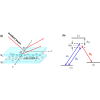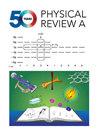增益辅助控制光子自旋霍尔效应
IF 2.9
2区 物理与天体物理
Q2 Physics and Astronomy
引用次数: 0
摘要
在光子自旋霍尔效应(SHE)(也称为横移)中,由于光的自旋轨道相互作用,具有相反自旋的入射光光子在横向上发生空间分离。在这里,我们提出了一种增益辅助模型来控制反射探针光中的 SHE。在这个模型中,探测光入射到一个包含三电平稀释气态原子介质的腔体上,原子与控制场之间的相互作用遵循双光子拉曼跃迁。我们的研究表明,在反常色散和正常色散状态下,光子自旋累积的方向可以跨越布儒斯特角在正值和负值之间切换。在控制场大小相同的情况下,反常色散区的光子 SHE 峰值要高于正常色散区。此外,与反常色散区相比,正常色散区布儒斯特角附近的角度范围更大。此外,光子 SHE 的峰值和角度范围可以通过改变控制场的拉比频率和探针场的失谐来控制。基于增益辅助的光子 SHE 测量可实现自旋相关应用,如光学传感。本文章由计算机程序翻译,如有差异,请以英文原文为准。

Gain-assisted control of the photonic spin Hall effect
In the photonic spin Hall effect (SHE), also known as the transverse shift, incident light photons with opposite spins are spatially separated in the transverse direction due to the spin-orbit interaction of light. Here, we propose a gain-assisted model to control the SHE in the reflected probe light. In this model, a probe light is incident on a cavity containing a three-level dilute gaseous atomic medium, where the interaction between the atom and the control field follows two-photon Raman transitions. We show that the direction of photonic spin accumulations can be switched between positive and negative values across the Brewster angle in both the anomalous and normal dispersion regimes. For the same magnitude of control fields, the peak value of the photonic SHE is higher in the anomalous dispersion region compared to the normal dispersion regime. Additionally, the angular range around the Brewster angle is wider in the normal dispersion regime than in the anomalous dispersion region. Furthermore, the peak value of the photonic SHE and the angular range can be controlled by changing the Rabi frequencies of the control fields and the probe field detuning. The measurement of photonic SHE based on gain assistance may enable spin-related applications such as optical sensing.
求助全文
通过发布文献求助,成功后即可免费获取论文全文。
去求助
来源期刊

Physical Review A
物理-光学
CiteScore
5.40
自引率
24.10%
发文量
0
审稿时长
2.2 months
期刊介绍:
Physical Review A (PRA) publishes important developments in the rapidly evolving areas of atomic, molecular, and optical (AMO) physics, quantum information, and related fundamental concepts.
PRA covers atomic, molecular, and optical physics, foundations of quantum mechanics, and quantum information, including:
-Fundamental concepts
-Quantum information
-Atomic and molecular structure and dynamics; high-precision measurement
-Atomic and molecular collisions and interactions
-Atomic and molecular processes in external fields, including interactions with strong fields and short pulses
-Matter waves and collective properties of cold atoms and molecules
-Quantum optics, physics of lasers, nonlinear optics, and classical optics
 求助内容:
求助内容: 应助结果提醒方式:
应助结果提醒方式:


